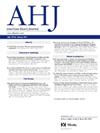成人先天性心脏病人工瓣膜心内膜炎的发病率和预后。
IF 3.7
2区 医学
Q1 CARDIAC & CARDIOVASCULAR SYSTEMS
引用次数: 0
摘要
背景:先天性心脏病(CHD)患者经常需要人工瓣膜植入术,这增加了他们一生中发生人工瓣膜心内膜炎(PVE)的风险。本研究的目的是确定成人冠心病患者PVE的发病率、危险因素和结局。方法:回顾性队列研究2003-2023年成人冠心病患者人工心脏瓣膜置换术。诊断为PVE的患者为PVE组,未诊断为PVE的患者为参照组。结果:9161例患者中,3150例(34%)采用人工瓣膜。在植入人工瓣膜的患者中,86例(2.7%)发生PVE,发生率为5.2(95%可信区间[CI] 4.8-1-5.6) / 1000患者年。86例PVE患者诊断时平均年龄为35±9岁,人工瓣膜置入术至PVE的平均间隔为91±27个月,平均随访时间为11.6±4.9年。发生PVE的危险因素为男性、低龄、2型糖尿病、多瓣膜置换术和Melody生物瓣膜置换术。经人口统计学/解剖学指标和合并症校正后,PVE与全因死亡率增加2倍以上相关(校正风险比2.21,95% CI 1.33-3.68, p=0.002)。86例PVE患者中,21例(24%)在随访期间死亡。PVE诊断后30天、1年和5年死亡率分别为1.6%、12%和15%。86例患者中,39例(45%)出现47例pve相关并发症(瓣膜周围脓肿[n= 21],脓毒性栓塞[n=26])。pve相关并发症与全因死亡率相关。结论:PVE在植入人工瓣膜的冠心病患者中很常见,并与全因死亡率相关。这些发现强调了人工瓣膜置入术对冠心病患者预后的影响,以及需要新的风险分层标准以改善预后。本文章由计算机程序翻译,如有差异,请以英文原文为准。
Incidence and outcomes of prosthetic valve endocarditis in adults with congenital heart disease
Background
Patients with congenital heart disease (CHD) often require prosthetic valve implantation, increasing their lifetime risk of developing prosthetic valve endocarditis (PVE). The purpose of this study was to determine the incidence, risk factors, and outcomes of PVE in adults with CHD.
Method
Retrospective cohort study of adults with CHD and prior prosthetic valve implantation (2003-2023). Patients diagnosed with PVE were designated as the PVE group, while the patients without PVE were designated as the reference group.
Results
Of 9161 patients, 3150 (34%) had prosthetic valves. Among the patients with prosthetic valve, 86 (2.7%) developed PVE, yielding an incidence of 5.2 (95% confidence interval [CI] 4.8-1-5.6) events per 1000 patient-years. Of the 86 patients with PVE, the average age at the time of PVE diagnosis was 35 ± 9 years, the average interval between prosthetic valve implantation and PVE was 91 ± 27 months, and mean duration of follow-up with11.6 ± 4.9 years. The risk factors for PVE were male sex, younger age, type 2 diabetes, multiple prosthetic valves, and Melody bioprosthetic valve implantation. PVE was associated with more than a 2-fold increase in all-cause mortality (adjusted hazard ratio 2.21, 95% CI 1.33-3.68, P = .002), after adjustment for demographic/anatomic indices, and comorbidities. Of 86 patients with PVE, 21 (24%) died during follow-up. The 30-day, 1-year, and 5-year mortality after diagnosis of PVE was 1.6%, 12% and 15%, respectively. Of 86 patients, 39 (45%) developed 47 PVE-related complications (perivalvular abscess[(n = 21], and septic emboli [n = 26]). PVE-related complications were associated with all-cause mortality.
Conclusions
PVE was common in CHD patients with prosthetic valves and was associated with all-cause mortality. These findings highlight the prognostic implications of prosthetic valve implantation in patients with CHD, and the need for new criteria for risk stratification in order to improve outcomes.
求助全文
通过发布文献求助,成功后即可免费获取论文全文。
去求助
来源期刊

American heart journal
医学-心血管系统
CiteScore
8.20
自引率
2.10%
发文量
214
审稿时长
38 days
期刊介绍:
The American Heart Journal will consider for publication suitable articles on topics pertaining to the broad discipline of cardiovascular disease. Our goal is to provide the reader primary investigation, scholarly review, and opinion concerning the practice of cardiovascular medicine. We especially encourage submission of 3 types of reports that are not frequently seen in cardiovascular journals: negative clinical studies, reports on study designs, and studies involving the organization of medical care. The Journal does not accept individual case reports or original articles involving bench laboratory or animal research.
 求助内容:
求助内容: 应助结果提醒方式:
应助结果提醒方式:


